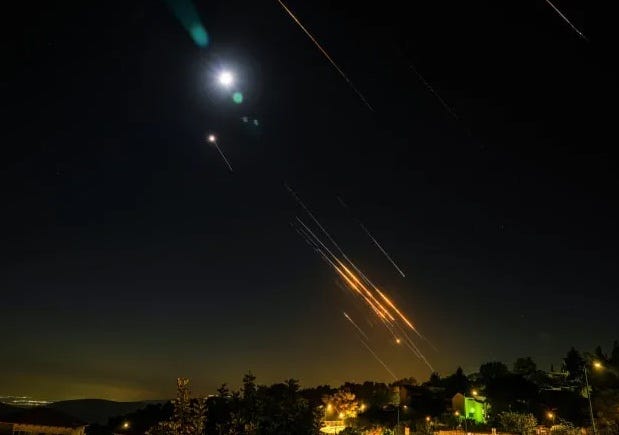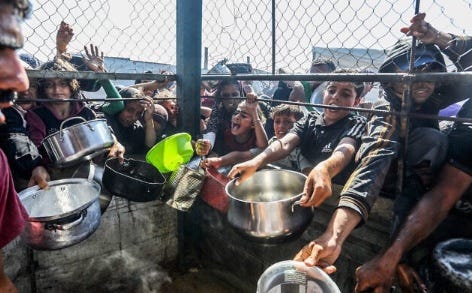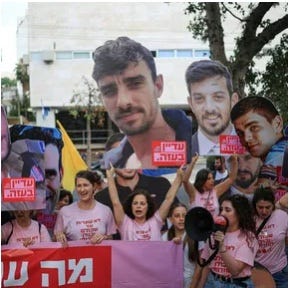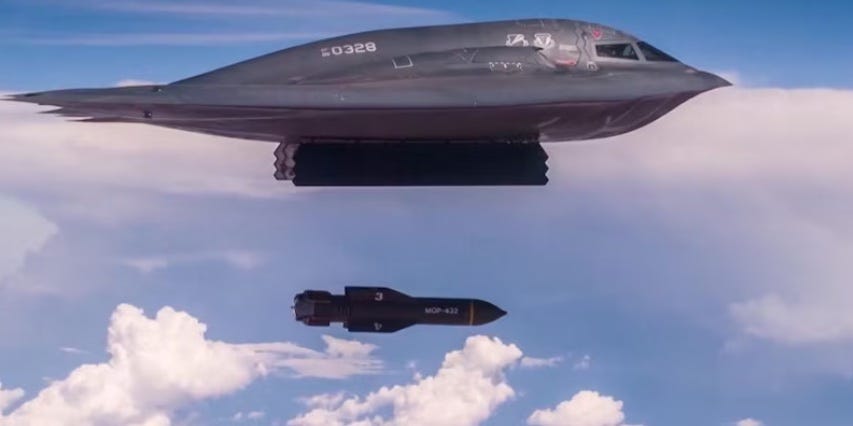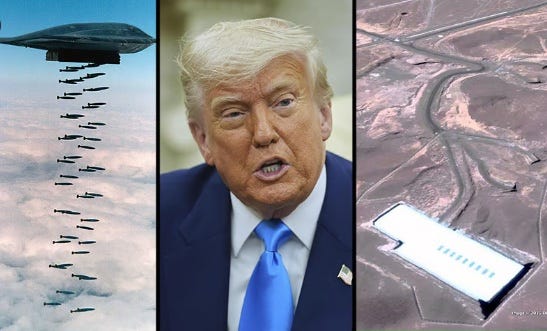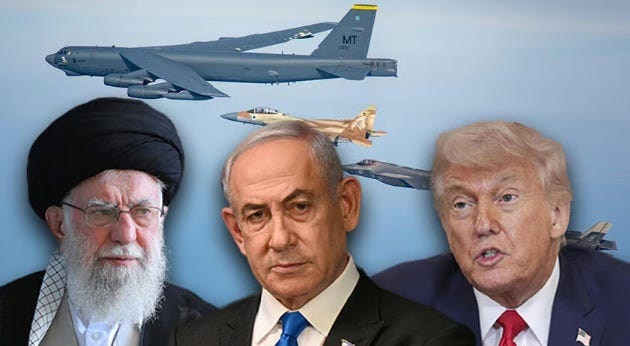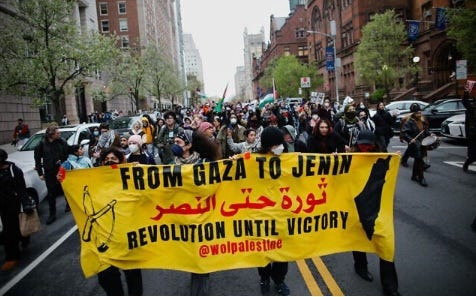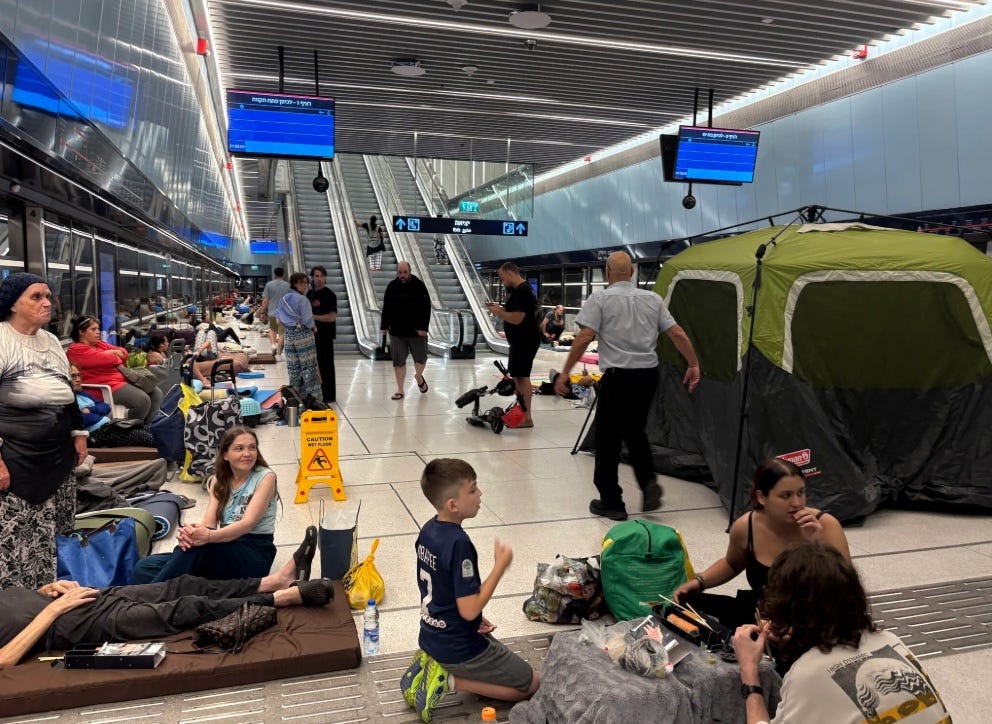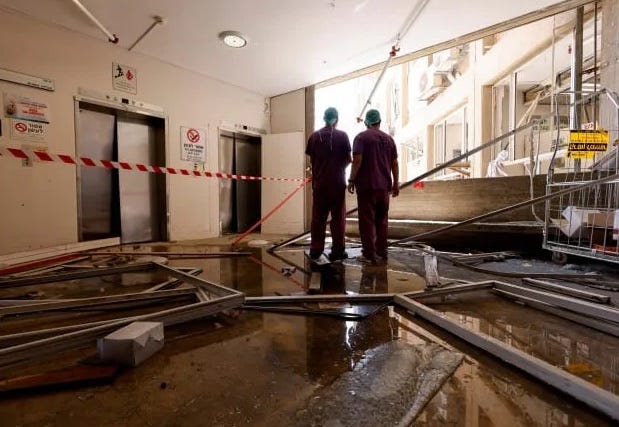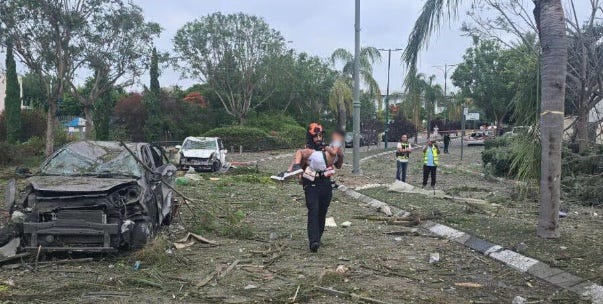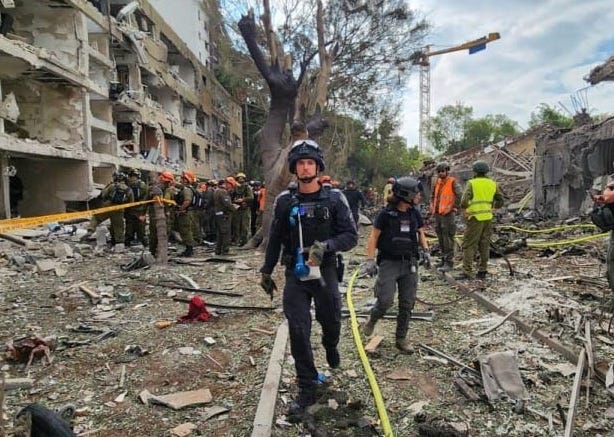War in Gaza Day 625, War with Iran Day 10
War
Iranian Missiles Over Tel Aviv
Israel is now at war on seven fronts, according to the IDF spokesman Gen. Effie Defrin.
The latest war is the one with Iran. As of June 22nd this war was in its 10th day. But Israel was no longer left to fight this war alone. One June 22nd the US sent B-2 bombers to take out three Iranian nuclear facilities.
Iran has been pummeling Israel with rockets since June 13th when Israel began operation Rising Lion to take out Iran’s nuclear facilities. Israeli politicians said then that Iran was only a few days or weeks from a nuclear weapon.
Within the first 24-hours of the fighting Israel took out most of Iran’s anti-aircraft batteries and radar detection, creating a corridor allowing attacking Israeli jets to fly nearly 2000 kilometers from Israel to their targets in Iran.
Israeli military experts told the media “We control the skies over Iran.” Israel is also fighting other wars; one in the north with Hezbollah, currently in ceasefire, with Gaza in the south, with Iran, with terrorists in the West Bank, with pro-Palestinian anti-Israeli propagandists around the world, and the Houthis in Yemen.
Full story below.
Gaza
IDF soldiers in Gaza
Operation Gideon’s Chariots, the latest operation in the war with Hamas in Gaza continues. Last week 4 more Israeli soldiers were killed, one by a sniper, the others either by an IED (roadside bomb) or an RPG (rocket propelled grenade). So far 431 soldiers have died in Gaza since the IDF operation began on Oct 27,2023.
GHF aid depot in Gaza
Bringing in and distributing aid in Gaza is still an issue. According to the Times of Israel a spokesperson for the Gaza Humanitarian Foundation (GHF), an organization backed by the United States and Israel that began distributing food rations in the Gaza Strip last month, said on Saturday June 13th that people in the Palestinian enclave “desperately need more aid.”
In that statement GHF interim executive director John Acree said that the organization was “delivering aid at scale, securely and effectively… But we cannot meet the full scale of need while large parts of Gaza remain closed.”
He said the GHF was “working with the government of Israel to honor its commitment and open additional sites in northern Gaza.”
Meanwhile, Ron Ben Barak, former assistant head of the Mossad, told Channel 12TV on Sunday morning June 22nd, that Israel had nothing more to accomplish in Gaza and should stop the war, pull out, and get the 53 hostages back. The only reason we’re still there is politics and two “mesuganes” (crazies, referring to Itamar Ben-Gvir and Bezalel Smotritch and their supporters).
North
Israel Defense Minister Yisrael Katz
Israel’s Defense Minister Yisrael Katz has warned Hezbollah leader Naim Qassem in Lebanon to stay out of the fight with Iran.
According to the Times of Israel, “The Hezbollah leader hasn’t learned from his predecessors and is threatening to act against Israel,” said Katz, referring to former Hezbollah chief Hassan Nasrallah, who was killed by Israel last September.
“I suggest that Iran’s Lebanese proxy be careful, and understand that Israel has lost patience with the terrorists who threaten it,” Katz added, warning: “If there is terror, there will be no Hezbollah.”
Since the ceasefire agreement with Lebanon on Nov 2024, the Times of Israel reports that over 180 Hezbollah operatives have been killed in Israelis strikes for violating the ceasefire agreement.
Hezbollah terrorist-fighters in Lebanon
On Wednesday night June 19th, the IDF killed Yassin Izz a-Din, commander of Hezbollah’s rocket artillery unit in the Litani River sector, in a strike on Barish, in southern Lebanon. The IDF announced this action on Thursday June 20th.
Also on Wednesday night, the IDF said it killed Mohammad Ahmad Khreiss, who it said was the commander of Hezbollah’s anti-tank unit in the Shebaa area. The IDF said Khreiss was responsible for many attacks against Israel including the death of Sharif Sawed, an IDF civilian contractor. A third Hezbollah operative trying to set up a terrorist infrastructure in South Lebanon was also killed on Thursday.
West Bank
IDF soldiers in the West Bank
On January 21, 2025 the IDF began a large-scale operation in the West Bank called “Iron Wall.” The IDF stated that the aims of Iron Wall are to preserve its "freedom of action” in the West Bank, to neutralize militant infrastructure, and to eliminate imminent threats.
According to the IDF, the Iron Wall has been yielding operational success. Sources say Israeli forces have seized control of the Jenin refugee camp, clearing it from militants, and have destroyed Nur Shams and the refugee camp in Tulkarm More than 40,000 Palestinians have been forced to leave their homes due to the operation,
Over the weekend of June 21st, the IDF and Israel Police arrested 18 suspected terrorists who were believed to be involved in arson and violence.
Hostages
Ofra Kadar (left) Jonathan Samerano (center) Sgt.Shay Levinson (right)
The Israeli government said that there is progress on the release of the 50 hostages still held in Gaza. Only twenty of them are believed to still be alive, according to sources in the Likud-led coalition government. However families of the hostages have stopped listening to these types of statements. They’ve heard them over and over and little has progressed, said a hostage’s family member.
On Sunday, June 22nd, the IDF announced that they had recovered the bodies of three slain hostages from Gaza in a military operation. The bodies of Ofra Kadar, 71 from Kibbutz Beeri, Jonathan Samerano, 22, from Tel Aviv who was at the Nova music festival when the Hamas invasion took place, and Sgt. Shay Levinson, 19, a tank commander on the Gaza border killed fighting the invading Hamas terrorists.
All were murdered by Hamas, on Oct 7, 2023 when thousands of Hamas terrorists invaded the settlements along the Gaza Israel border, under the umbrella of thousands of rockets fired by Hamas into Israel. In the invasion terrorists killed over 1200 people and took 251 captive. These three bodies were recovered by a joint IDF and Shin Bet operation.
Families of Hostages protest in Tel Aviv
According to the Times of Israel, The Hostages and Missing Families Forum welcomed the return of the bodies of three slain captives in a statement in which it also urged the government to use the Iran war’s momentum to secure a deal to free the remaining hostages.
“We wish to express our deep gratitude to the IDF and security forces who acted with dedication and courage,” the forum said in a statement. “The return of all the hostages is an essential condition for the process of national healing and recovery.”
The Families Forum urged the government to take advantage of the severe blows dealt to Iran, the main backer of the Hamas terror group, to reach a hostage deal.
Red Sea
Houthi Fighter in Yemen
According to the Economic Times of India, Houthi rebels in Yemen, backed by Iran, have issued a stark warning, threatening to target US ships and warships in the Red Sea. This threat on Saturday came in a prerecorded video statement by Houthi military spokesman Brig Gen Yahya Saree.
This comes in response to the US military involvement alongside Israel in a conflict against Iran.
However, according to the Jerusalem Post, Any attacks on shipping would harm Egypt due to its reliance on the Suez Canal, and it would anger the Emirates and Saudi Arabia. The Houthis and Iran will need to weigh this amid recent tensions.
The US Navy has also positioned the amphibious assault ships the USS Kearsarge and Arleigh in the Arabian Sea as well as the Bork-class guided missile destroyer USS Bainbridge.
Iran
B-2 Spirit Stealth Bombers
At approximately 03:10 Israel time (02:10 Iranian time) on June 22nd, six US B-2 Spirit stealth bombers, with a bat-like aerodynamic shape, flew 37 hours from Whitman air force base in Missouri to Iran. The flight took about 18 hours in each direction. The planes refueled in flight after takeoff. To throw off surveillance, at one point there were more B-2 bombers all headed to Guam, but some continued west while six continued east. News reports focused on those heading west while those heading east snuck under the public’s eye.
The flight was 7,000 miles roundtrip(11,400 kilometers) from Whitman air force base in Missouri to Iran. Once in Iran the six B-2 Spiit Stealth bombers dropped over 22 tons of explosives on Iranian nuclear sites at Fordo, Natanz and Isfahan using MOP (Massive Ordnance Penetrator) bunker buster bombs and Tomahawk missiles from from US submarines.
According to CBS news, this was the second time Isfahan was hit. The first time was in the first 24 hours of the war as part of Israel’s goal to destroy the Iranian nuclear program.
The US Navy submarines reportedly fired 30 TLAM (Tomahawk Land Attack Missiles) long-range, all weather, jet-powered, subsonic cruise missiles, at Natanz and Isfahan.
B-2 Spirit Stealth Bomber dropping MOP
Each MOP weighs approximately 30,000 pounds (13,600 kilograms) and is engineered to penetrate up to 200 feet of earth or 60 feet of reinforced concrete before detonating, making it one of the most powerful conventional bombs in the U.S. arsenal. This was the first time these bombs were used in a combat situation.
B-2 dropping bombs, President Trump, Fordo site
The main target was the Fordo centrifuges built 300 feet beneath a mountain and shielded by Russian-supplied air defenses. Fordo was considered the crown jewel of Iran’s nuclear program, housing 1,000 centrifuges used for uranium enrichment. US President Trump declared the site “gone” after the MOP strikes. However, there has as yet been no verification that the site was destroyed.
The second target was Natanz, Iran’s main uranium enrichment facility. Natanz was reportedly hit with two MOP bombs and Tomahawk missiles that struck both above ground infrastructure and underground centrifuges.
The third was Isfahan: This site was hit primarily by Tomahawk missiles, damaging critical buildings.
According to Ynetnews, the American administration is preparing for the possibility of an Iranian response in the coming days. Two security officials and a White House senior official told NBC News that the next 48 hours are considered especially critical.
According to the US sources, it is unclear whether Iran will choose to strike American targets overseas, within U.S. territory, or attack both simultaneously. One analyst thought Iran would strike a US target to safe face and then come to the negotiating table. However Gen. (ret.) Amos Yadlin told Channel 13 news that he thought Iran would be very careful striking any USA targets.
Two sources familiar with military planning reported earlier this week that Iran has contingency plans to attack American bases and assets in the Middle East if necessary, although at this stage there are no signs of immediate preparations for such action
US President Trump Explains Bombing of Iran
US President Trump also thanks Israel’s Prime Minister Netanyahu saying the two worked as a team to carry out this attack aimed at eliminating Iranian nuclear capabilities. President Trump called Iran the ‘bully” of the region that should now come to the negotiating table or face even worse attacks.
According to the Jerusalem Post, deception and misdirection played a large part in the success of the B-2 attack. On Sunday June 22nd, US Joint Chiefs Chairman General Dan Caine and US Secretary of Defense Pete Hegseth gave the full details and background on how American forces used decoys, stealth aircraft, and mega bunker buster bombs to attack three key Iranian nuclear facilities in just 25 minutes.
Caine explained that a larger number of aircraft than those which eventually struck Iran flew from Missouri in the direction of Iran initially, but that then the majority of the aircraft split to the West as a decoy.
Diagram of the MOP
He said the US used 75 precision-guided weapons throughout the operation.
According to Ynetnews, Israel’s president Yitchak Herzog praised the US strike on Iran’s nuclear sites on Sunday morning.
Israel’s President Yitzchak Herzog
"In the pages of human history, this is a moment when the principles of liberty, responsibility, and security have triumphed. A decisive moment between the axis of terror and evil and the axis of hope," Herzog wrote on X.
Herzog thanked US President Donald Trump and the US in general.
"This brave step serves the security and safety of the entire free world. I hope it will lead to a better future for the Middle East, and help advance the urgent release of our hostages held in captivity in Gaza," the president wrote.
A few days previously, Herzog told the Times of Israel, “Iran is waging a war against the Jews, while Israel is waging a war to defend the West.”
According to Ynetnews, Israel’s opposition Leader Yair Lapid said in a statement, "This night is a historic night for the entire Middle East. Thank you to President Trump. Thank you to the United States. A nuclear Iran is a threat to the whole world, tonight, a nuclear arms race in the Middle East was prevented."
However, according to AP, following U.S. President Donald Trump assertion in an address to the nation from the White House that Iran’s key nuclear sites were “completely and fully obliterated”. Iran’s Foreign Minister Abbas Araghchi said the time for diplomacy had passed and that his country had the right to defend itself.
In the first comments by a high-ranking Iranian official since the strikes, Araghchi said in Turkey that the U.S. had “crossed a very big red line.”
“The warmongering, a lawless administration in Washington is solely and fully responsible for the dangerous consequences and far reaching implications of its act of aggression.
Iran is a close ally of Russia, and has actively supported it in its war on Ukraine, supplying it with attack drones. Araghchi said he would be flying immediately to Moscow to meet with President Vladimir Putin “and coordinate our positions.”
Iranian Khamenei, (left) Israel’s Netanyahu (center) US Pres.Trump (right)
Iran’s Supreme Leader Ayatollah Ali Khamenei had warned the United States on Wednesday that strikes targeting the Islamic Republic will “result in irreparable damage for them.” And Iranian Foreign Ministry spokesman Esmail Baghaei declared “any American intervention would be a recipe for an all-out war in the region.”
There have been calls to assassinate Supreme Leader Khamenei, “chopping off the head of the snake,” as some phrased it. However, on Saturday June 21st, Iran’s Supreme Leader Khamenei named three possible successors, all senior clerics, as possible replacements should he be killed.
According to AP, the Israeli Military said Saturday it was preparing for the possibility of a lengthy war, while Iran’s foreign minister warned before the U.S. attack that American military involvement “would be very, very dangerous for everyone.”
Israeli strikes on Iran have killed at least 865 people and 3,396 others, according to the Washington-based group Human Rights Activists. The group said of those dead, it identified 363 civilians and 215 security force personnel.
Trump’s decision for direct U.S. military intervention comes after his administration made an unsuccessful two-month push, including with high-level, direct negotiations with the Iranians, aimed at persuading Tehran to curb its nuclear program.
During his previous administration, Trump pulled the U.S. unilaterally out of the 2015 nuclear deal with Iran, prompting Tehran to begin enriching uranium to higher levels and restrict the access of IAEA inspectors to its facilities.
According to Ynetnews, EU foreign policy chief Kaja Kallas announced that EU foreign ministers will hold discussions Monday June 23rd on the Middle East situation in the shadow of the American strike on Iran's nuclear facilities. "Iran must not be allowed to develop nuclear weapons, which would pose a threat to international security," she wrote on her X account. "I urge all parties to take a step back, return to the negotiating table and prevent further escalation."
According to Reuters, Britain was updated in advance about the operation. According to him, Prime Minister Keir Starmer "is holding conversations with our key partners. We have deployed military assets to the Middle East, and we will act to protect the interests of Britain, the US and NATO in the region."
According to Ynetnews, in addition to the strike on the Frodo, Nantanz and Isfahan bases, the Israeli air force Israeli attacked two F5 fighter jets of the Iranian military forces at Dezful Airport in Iran.
According to IDF Spokesman Brig. Gen. Effie Defrin, at his Saturday June 21st briefing, on the ninth day of Operation Rising Lion.
“Approximately 60 fighter jets guided by precise intelligence carried out a strike deep within Iranian territory," IDF Spokesperson Brig.-Gen. Effie Defrin said in his Saturday evening briefing
During his briefing, he also stated that the IAF is "hitting every element in the missile production chain, preventing the Iranian military from advancing its strategic capabilities."
The IDF spokesperson noted that earlier eight launchers were destroyed, including six that were ready for immediate launch toward Israel. It was also reported that about 20 Air Force fighter jets attacked dozens of military
Iran’s Arak nuclear reactor
Gen. Defrin also said that the targets in central Iran that were hit last night, had precise intelligence guidance from the Intelligence Division. Among the targets were a military site with components for making explosives, sites for storing and producing weapons and Iranian air defense systems.
Also, according to the Jerusalem Post, the Israeli Air Force bombed Iran’s Arak heavy water reactor Thursday morning June 19th, along with a second strike on the Natanz enrichment facility and dozens of other military sites. The military said this was part of the operation aimed at destroying the Iranian nuclear program.
On Thursday, according to the Israel Defense Forces, the air force conducted a wave of overnight strikes involved 40 fighter jets dropping 100 munitions on dozens of Iranian military facilities in Tehran and other areas of Iran.
One of the strikes was aimed at the Arak nuclear site, yet another aspect of the Iranian nuclear weapons program. The IDF issued a warning ahead of the strike on the Arak reactor and urged residents in nearby areas to flee.
“The strike targeted the component intended for plutonium production, in order to prevent the reactor from being restored and used for nuclear weapons development,” the military said.
The research reactor was only partially built, with Tehran informing the UN nuclear watchdog that it planned to begin operating the facility next year.
Also, according to the Jerusalem Post, earlier in the week an IDF drone struck two Iranian F-14 fighter jets in an Iranian airbase minutes before they were set to take off
This was revealed by the Israeli military on Monday evening. June 16th. One other F-14 was hit by IAF fighters all in an Iranian air force base the heart of Tehran. Iran is the only country in the world to still use the F-14s.
Iran received 79 of the US-made F-14's in 1976 when the country was still ruled by the Iranian Shahs. The F-14 was retired by the US Navy in 2006, being replaced by the F-18.
And, according to AP, U.N. Secretary-General Antonio Guterres called the strikes a “dangerous escalation,” as world leaders began chiming in with calls for diplomacy.
“There is a growing risk that this conflict could rapidly get out of control — with catastrophic consequences for civilians, the region and the world,” he said in a statement.
According to Reuters, the Russian Foreign Ministry condemned the American strikes on Iran's nuclear facilities, stating that "the irresponsible decision to attack Iran is a violation of international law. The danger of conflict in the Middle East has significantly increased." The ministry also stated that Russia "calls for an end to the aggression and increased efforts to create conditions for returning to a diplomatic and political track."
According to the Israel Democracy Institute, 82% of the Jewish public supports Israel’s attack on Iran and the timing of the attack. 65% of the Arab public opposes both the attack and the chosen timing. Some two-thirds of the Jewish public believe that Prime Minister Netanyahu’s motives for launching an attack at this time were mainly objective and security-related. Two-thirds of the Arab public think that his motives were mainly subjective and political.
Still, there are those who are skeptical that the US attack completely destroyed Iran’s nuclear capability.
Speaking to Israel TV’s Channel 12TV Gen (ret.) Eytan Ben Eliahyu, former head of the Israel Air Force, said that the Fordo site was nearly 4 miles, (@6 kilometers) across. “We don’t know exactly where everything is in Fordo, just as we didn’t know where all the tunnels were in Gaza. We have to hit the site again and again.”
Speaking to Israel TV’s Channel 12, Ron Ben Barak, former Assistant head of the Mossad, said, “At least we’re not alone with this fight any longer.” Ben Barak said that Israel always had a plan to destroy Iran’s nuclear program, but they had taken the ‘little by little’ approach up until now.
Ben Barak didn’t think the bombing of the nuclear program was the end of the war. “I don’t think the fundamentalist ayatollah’s regime will quickly raise the white flag.” But he said he hopes the regime will take a step back and decide what to do to stay in power.
He also pointed out the danger of the missing 400 kg of enriched uranium the Iranians reportedly smuggled out of the Fordo facility before the US attack. We have to find the missing 400 kg.”
And, he said, Israel had to make sure that Iran won’t send 1000 missiles at us.
According to Ohad Hemo, Arab affairs correspondent at Channel12TV, Iran was shipping as much enriched uranium as they could out of the country. Iran also claimed that the missing uranium was in their hands.
Former Chief of Staff Gen. (ret.) Gadi Eiskott told Channel 12TV that 20 years of planning went into one week of war. He said Israel needs to fight short wars. He thought Israel should make a deal in Gaza and get back the Hostages. He said that Iran was pouring money into Gaza. The way may cut off that money stream and help get the hostages back.” Relating the war with Iran Eisenkott said “Israel is fighting the war (with Iran) for the good of the entire world.”
Former head of Israel’s National Security Council Gen. (ret.) Yakov Amidror said that Iran had the goal to enrich uranium, but if there isn’t a way to we-anise it, to use it, there is not point. If the Fodor facility is destroyed the Iranians will probably have to go into negotiations. Part of the negotiations would have to be to give up their enriched uranium, probably give it over to the Russians.
According to the British Sun newspaper, Iran claims it evacuated key assets in advance, and the International Atomic Energy Agency (IAEA), along with Gulf nations, found no abnormal radiation levels. Such levels should be present if a nuclear facility were hit.
And according to the IAEA, Iran’s stockpile of 60% enriched uranium has risen sharply, over 400 kg by May 2025, enough material for several nuclear devices if further refined.
According to some pundits, The U.S. strikes have severely disrupted some key nuclear infrastructure, but Iran’s core capabilities remain intact. Stockpiles of enriched uranium were untouched. The Iranian nuclear program and talent, even with those scientists killed, is still in place.
Iran retains enriched uranium and f functional, or easily repairable, centrifuge infrastructure. Iran could produce weapons grade uranium in days to weeks. Weaponizing (building a bomb and mounting it on a missile, could take months to a year, or more. If at all give that the experts for putting together the bomb have been killed by Israeli attacks.
Israeli observers, however, are satisfied. “This pushed the Iranian program back months, if not years,” said former Minister of Defense Gen (ret.) Yoav Gallant. But, he also said, “We must keep attacking until their ability to send missiles at us is removed.”
Ehud Yaari, a veteran Arab affairs correspondent told Channel 12TV that the likely scenario Israel now faced is a war of attrition with Iran. Unless the US can come to some agreement with them.
Yaari said that the Iranian foreign minister had flown to Moscow. Yaari expects Iran to ask the Russians to intercede with the US to bring about a ceasefire. Yaari said that in his opinion Khamenei was a practical man and would do what he could to stay in power.
Antisemitism
2024 Pro-Palestinian parade outside Columbia university
According to the Times of Israel, the third report by Columbia University’s antisemitism task force shows that over half of Jews, and 43% of Muslims, have experienced religious discrimination at the university, compared with 10% of student body at large
The Times of Israel reported that US campuses have seen a steep increase in anti-Israel activity amid the war in Gaza, which was sparked when thousands of Hamas-led terrorists stormed southern Israel to kill some 1,200 people and take 251 hostages.
A pro-Palestinian, anti-Israel encampment initiated at Columbia in the spring of 2024 triggered an international trend and caused many Jewish students on campus to report feelings of discomfort and isolation.
One observer asked if isolationism, antisemitism, or just plain old politics, was the cause of the bro-ha-ha between former Fox News conservative commentator Tucker Carlson and Fox News’ Sean Hannity. The two got into a heated argument over the pros and cons of US involvement in the Iran-Israel war.
On June 14th, right wing commentator Carlson called Hannity and other MAGA hawks ‘warmongers’ for cheering Israel’s missile strikes against the Iranian regime.
The US congress also has those for and against the US involvement with Israel’s war with Iran. Some of those opposed, like Palestinian/American Alexandria Ocasio-Cortez, were expected to be against any move to help Israel.
According to Reuters, Democratic Representative Ocasio-Cortez of New York said: "The president’s disastrous decision to bomb Iran without authorization is a grave violation of the Constitution and Congressional War Powers. He has impulsively risked launching a war that may ensnare us for generations. It is absolutely and clearly grounds for impeachment."
"This is not constitutional," conservative Republican Representative Thomas Massie of Kentucky said on social media. He was referring to the power of Congress to declare war on foreign countries.
U.S. House Democratic Leader Hakeem Jeffries said: "President Trump misled the country about his intentions, failed to seek congressional authorization for the use of military force and risks American entanglement in a potentially disastrous war in the Middle East.”
"Donald Trump shoulders complete and total responsibility for any adverse consequences that flow from his unilateral military action,"Jeffries said.
However, Senate Armed Services Committee Chairman Roger Wicker, a Mississippi Republican, applauded the operation but cautioned that the United States now faced "very serious choices ahead."
Senate Foreign Relations Committee Chairman Jim Risch, Republican of Idaho, said: "This war is Israel’s war, not our war, but Israel is one of our strongest allies and is disarming Iran for the good of the world." Risch added: "This is not the start of a forever war. There will not be American boots on the ground in Iran."
U.S. House of Representatives Speaker Mike Johnson, a Republican of Louisiana, said, "The president gave Iran’s leader every opportunity to make a deal, but Iran refused to commit to a nuclear disarmament agreement."
"The president’s decisive action prevents the world’s largest state sponsor of terrorism, which chants 'Death to America,' from obtaining the most lethal weapon on the planet."
Senate Majority Leader John Thune, a South Dakota Republican, said: "I stand with President Trump."
Politics
Israel’s Prime Minister Benjamin Netanyahu
One pundit said that Israel is now locked into a period of national unity. During the war with Iran no Israeli politician come forward with criticism of Prime Minister Netanyahu, even those who dislike him.
However, some cynics still thought Netanyahu started this war with Iran as a distraction from his corruption trial and the growing public unease with the war in Gaza.
Some pundits brought up former Prime Minister Ariel Sharon’s 2005 disengagement from the Gaza strip’s Jewish settlements, claiming this was a distraction from a criminal investigation into his dealing with a real estate project. Others pointed to former Prime Minister Menachem Begin’s 1981 attack on the Iraqi Osirak nuclear rector as a way to distract from his lagging in the polls.
However, almost all agree that Iran was an implacable enemy and needed to be neutered. What will happen if and when there is peace with Iran is still an open question.
Editorial
Iran has been steadily firing missiles and drones at Israel as the war entered its tenth day. The news that the B-2 bombers had struck Iran was greeted with sighs of relief and cheers. Pundits been discussing the pros and cons of striking at Iran’s nuclear capability for nearly two decades.
Today, Israel is able to detect and destroy between 85%- 90% of all missiles launched from Iran and nearly 99% of all drones.
Israel’s military is able to detect when Iran launches their missiles, and immediately sends fighter jets or armed drones to take out the launchers.
Israel’s Home Front Command has also begun a system of sending out a screeching alarm to mobile phones around the country providing what was assumed to be a ten-minute warning from launch until Iranian missiles struck. This alarm allowed people to prepare themselves and the surroundings for the attack and make their way to bomb shelters and safe rooms.
Then a siren would blare approximately two minutes before the missile or drone was near the target sending millions of Israelis into their safe rooms or bomb shelters.
But a large segment of the Israeli population found themselves defenseless. They lived in old buildings that had no safe rooms, or neighborhoods without adequate bomb shelters, or no shelters at all.
Following the example of the British during the Blitz, when Nazi planes bombed London during WWII, Israelis began to seek shelter in underground railroad platforms, in basement parking lots, in public shelters in malls, or as a last resort, under the stairs in the staircase.
Israelis take shelter in Tel Aviv Train Station
Even army bases were at risk. Some had no protection and the officers families were told to evacuate. Others told the combat soldiers, some in elite commando units, to find another place to stay until they were called to action.
Speaking on Channel 12TV, Yoav Gallant, former minister of defense, was asked about the lack of bomb shelters in public areas and on bases. “These things take time to budget, get approvals for, and build. The plans are all in the works.” He also pointed out that as a youngster during the Yom Kippur War he had to dig out a fox-hole with his hands to hide from potential incoming ordinance.
Speaking on Israel TV’s Channel 12TV, Yariv Bar David told a reporter that he was in his ‘safe room’ in Beer Sheva with his family when he felt the ground shake, dust and smoke fill up the room and the electricity failed. Following the all clear issued by the Home Front Command on his mobile phone, he came out to see his home badly damaged. He profusely thanked the Home Front Command for stressing that the population take shelter. “They saved my life and that of my family,” he said standing before the rubble of his home.
Others weren’t so lucky. In one attack a missile made a direct hit on a building piercing the safe room and killing those inside.
Building and homes damaged in Tel Aviv
So far 24 Israelis have been killed and hundreds injured in the War with Iran. Over 400 ballistic missiles and 1100 drones have been launched at Israel since the War with Iran began on June 13th.
Saroka Hospital Beer Sheva
The most egregious attack was the missile that hit Beer Sheva’s Saroka hospital, doing severe damage to the sixth and fifth floors. According to hospital director general Prof. Shlomi Codish, those floors had been evacuated at the start of the war with Iran and the patients and clinics moved underground.
Speaking on Channel 1 Kan TV, Moshe Bar Shalom, director-general of the Minister of Health, said that he’d toured Saroka hospital and found that the security and safety of the patients and staff was at risk. He said he told the head of the hospital to move the operating theaters underground. A move, he said, that resulted in saving many lives. While nearly two hundred people were injured in the hospital blast most were only lightly injured.
Some Israeli politicians, like Defense Minister Israel Katz, were incensed by the Iranian bombing of the hospital and called for the assassination of Iranian supreme leader Khamenei.
However, Gen. (ret.) Gadi Eisenkott, former IDF chief of staff, told Channel 12TV that Israel shouldn’t get side-tracked by emotions. Israel had to stick to the plan and focus on the main goal, destroying Iran’s nuclear capability.
Firefighter rescues child after Iranian missile attack
Meanwhile, Iranian missiles have struck all across the country. A missile landed near the oil storage facility in Haifa killing three people. Another in a home where three people were killed who did not go into their safe rooms.
Iran has also begun to use missiles with cluster-bomb warheads containing mini bombs that can fly as far as 4-6 miles on impact of the warhead cutting a path of mayhem and destruction.
Iranian Missile Damage in Israel
Shortly after the B-2 bombs destroyed the Iranian nuclear reactors, Iran launched a wave of missile attacks, damaging buildings in the Tel Aviv area, in Haifa and as far south as Beer Sheva.
Prior to the strike by the B-2 bombers, an earlier swarm of drones had been launched from Iran. Their flight time was seven hours. They arrived at approximately 07:40 in the morning. Shortly after another siren sounded announcing the arrival of 20-30 Iranian ballistic missiles.
At 08:02 another attack of five rockets was fired from Iran, these struck in the Tel Aviv, Haifa and Nes Ziona areas. Ten sites were hit by the missiles from the north to the south.
These strikes took were Iran’s paramilitary Revolutionary Guard’s response to the U.S. B-2 bomber attacks. The Revolutionary Guard gave details, saying it had launched a barrage of 40 missiles at Israel, including its Khorramshahr-4, which can carry multiple warheads. Israeli authorities reported that more than 80 people, including 3 children, were wounded but suffered mostly minor injuries.
In Sunday morning’s attacks, a multi-story building in Tel Aviv was significantly damaged, with its entire façade torn away to expose the apartments inside. Houses across the street were almost completely destroyed.
Following the Iranian barrage, Israel’s military said it had “swiftly neutralized” the Iranian missile launchers that had fired at Israel, and that it had begun a series of strikes toward military targets in western Iran.Israel is bracing for more Iranian attacks. The Home Front Command has issued new warnings, advising people to stay close to home, to limit gatherings to 30 people and then only if there is an approved safe room or shelter.
Pundits wonder what will be next? Will Iran turn their wrath to America or focus on the ‘Little Satan’ Israel? The US has long been called the Big Satan by Iran and Israel the Little Satan.
Iran has juicy US targets in the middle east. The US has over 40,000 troops in army and air force bases throughout the region. Iran has also threatened to mine the Straits of Hormuz to shipping, a move that would cut off the supply of oil to the world.
1200 Kilometers away, the Houthis in Yemen have threatened to resume bombing Israel and the sea lanes off their coast should the US join Israel in the war against Iran. Analysts are waiting to see if the Houthis make good on their threats.
Iran has long been considered a destabilizing force in the Middle East, exporting their fundamentalist ideology to entities like Hezbollah and Hamas.
Recently, the IDF released documents it found in the rubble of a Hamas command center beneath the Europe hospital in Gaza’s Khan Younis area, the same center that the IDF bombed killing Hamas leader Mohammed Sinwar.
Among the documents were papers from Iran to Hamas committing Iran to supplying weapons and funds to the terrorist group. The documents discovered by the IDF detailed correspondence between IRGC’s (Iranian Royal Guard Command) Saeed Izadi, who was killed on Saturday June 14th, and Mohammed Sinwar, regarding the transfer of weapons to Hamas.
According to the Jerusalem Post, the correspondence between Sinwar and Izadi revolved around a "Tufan 1" project, under which the IRGC commander attempted to transfer weapons valued at what the IDF said was some $21 million, from Iran to the Gaza Strip.
In addition, documents showed the planned transfer of more weaponry valued at around $25 million, under the project name "Tufan 2."
"For years, Izadi transferred weapons to support Hamas’ terrorist activities against the State of Israel and continued attempting to do so in recent months," the military release said
Analysts say that this is just one example of how Iran has tried to export the brand of Islamic Fundamentalism instituted by Ayatollah Khoumeni, the founder of the present Iranian regime.
Iranian proxies like Hezbollah in Lebanon, the Houthi’s in Yemen, Hamas in Gaza, and others have wrecked havoc on the world. Not only was Iran behind the bombing of a US Marine base in Lebanon in 1983, using their proxy Hezbollah, when two truck bombs exploded killing 241 US service members, but also the attack on the Argentinian Jewish community in 1994 when a truck bomb exploded near the AMIA Jewish center in Buenos Aires killing 85 people and injuring over 300. A 2006 report found Iran guilty of the crime.
A regime change would be a welcome side effect of the war on Iran’s nuclear facilities, said Prime Minister Netanyahu. However, no suitable democratic candidate has been forthcoming, except for Reza Pahlavi, the unpopular Crown Prince of Iran, who fled Iran 46-years ago when his father was deposed. Until a suitable replacement for Khamenei is found, removing him would not solve any problems.
Because of the war with Iran, and the risk of planes being hit by incoming missiles, flights into and out of Israel were cancelled, causing over 150,000 Israelis to be stranded outside the country. Many made their way to Cyprus, hoping to find a plane or boat to take them the 190 mile (305 kilometers) to Israel. Israel has recently begun to allow El Al and Israir to operate rescue flights from Cyprus to bring stranded Israelis back to Israel.
According to Israel Radio’s Reshet Bet, some stranded Israelis even flew to the Sinai desert resort of Sharm El Shek and made their way by land across Egypt to the Israeli boarder. Still others flew into Jordan and made their way overland into Israel.
Also, last week, an agent of the IRGC (Iranian Revolutionary Guard Corp) was arrested in Cyprus apparently preparing an attack
The Azerbaijani national was arrested on Friday after security services received “highly classified and reliable intelligence from a cooperating foreign service.” The foreign intelligence identified the man as an IRGC operative, the report said.
Some speculate the IRGC agent was planning an attack on Israelis stranded on the Island awaiting transport back to Israel
Others say he was planning an attack on foreign military forces in Cyprus. .
According to the BBC, the agent is thought to have carried out surveillance for Iran on the RAF Akrotiri base on the island.
Then there is the logic in Israel’s push to destroy the Iranian nuclear weapons threat.
One history professor said that no one has used an atomic weapon since WWII. He doubted if Iran would use a weapon if they had one.
When asked if Hitler would have used an atomic weapon on the Jews if he’d had one, the professor said, “Yes, of course.”
So why would a ruler and a regime who have consistently declared their intention to destroy Israel and the Jewish people, and the USA if they could, refrain from using the weapon?
To that, the professor had no answer.




